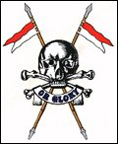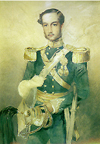This information has graciously been shared with the Victorian Web by Stephen Luscombe and has been taken from his website. Copyright, of course, remains with him. Added by Marjie Bloy, Ph. D., Senior Research Fellow, the Victorian Web
 The 17th Light
Dragoons were renamed and rearmed into Lancers in 1822 and 1823. The reasoning
behind the move was in imitation of the Polish Lancers who had fought so well
alongside Napoleon. It was the Duke of York, the Commander-in-Chief, who first
proposed the idea in 1816. The first unit to be converted to Lancers was the
9th Light Dragoons, but this was deemed to have been sufficiently successful
that another five regiments were chosen for conversion, the l7th Light Dragoons
was one of those five. The Polish connection is not hard to miss: the uniforms,
lances and pennants can all be traced in style to the Polish regiments that
inspired them. Perhaps the biggest surprise was that the regiments were forced
to abandon their carbines in order to make room for the Lances. It would be
another sixty years before they realised that the Carbines really were intrinsically
important to the effectiveness of Light Cavalry. It could be said that the graduation
of the unit from Light Dragoons to Lancers was actually a step back in to time
rather than a practical military advance in technology. It would take the Crimean
war to demonstrate just how much more innovation was needed to make the British
forces into an effective fighting force.
The 17th Light
Dragoons were renamed and rearmed into Lancers in 1822 and 1823. The reasoning
behind the move was in imitation of the Polish Lancers who had fought so well
alongside Napoleon. It was the Duke of York, the Commander-in-Chief, who first
proposed the idea in 1816. The first unit to be converted to Lancers was the
9th Light Dragoons, but this was deemed to have been sufficiently successful
that another five regiments were chosen for conversion, the l7th Light Dragoons
was one of those five. The Polish connection is not hard to miss: the uniforms,
lances and pennants can all be traced in style to the Polish regiments that
inspired them. Perhaps the biggest surprise was that the regiments were forced
to abandon their carbines in order to make room for the Lances. It would be
another sixty years before they realised that the Carbines really were intrinsically
important to the effectiveness of Light Cavalry. It could be said that the graduation
of the unit from Light Dragoons to Lancers was actually a step back in to time
rather than a practical military advance in technology. It would take the Crimean
war to demonstrate just how much more innovation was needed to make the British
forces into an effective fighting force.

This
image has been taken from Stephen Luscombe's website.
Copyright, of course, remains with him.
Click on the image for a larger view and more information.
The new uniforms represented a huge investment in time, money and effort for the soldiers to look presentable. It is from this era that the 17th took on another of its nicknames 'Bingham's Dandies' after its new Lieutenant Colonel Lord Bingham. He was a stickler for presentation and invested in the finest horses and tailors to produce incredibly ornate uniforms. In the long years of peace of this period, it was appearance that took precedence over military effectiveness. Thirty four years of peace time activities for the regiment were about to be shaken by war in the East.
The Crimean War
In 1854 the 17th Lancers were ordered abroad as part of an Anglo-French expeditionary
forces to help Turkey who had been invaded by Russia.
Upon arrival the force discovered that the Turkish Army had repulsed the Russian
invasion. It was then decided to capture the Czar's intended fleet base at Sebastopol.
In order to achieve this, the force passed to the South of the town to the small
fishing village of the new famous Balaklava.
Charge of The Light Brigade
The battle of Balaklava consisted of three distinct actions. In the first, the 93rd Regiment of Foot (now the Argyll and Sutherland Highlanders), withstood and repulsed an attack by a vastly superior force of Russians. The second is remembered as "The Charge of the Heavy Brigade", in which a number of Dragoon Regiments routed a force of Russians ten times their strength. The third and final action in which the 17th Lancers were involved and which is still celebrated every year on 25th October, was "The Charge of the Light Brigade", immortalised in the poem by Alfred, Lord Tennyson. This famous charge only took place as a result of misinterpreted orders issued by the Command in Chief, General Lord Raglan, to General Lord Lucan the Commander of the Cavalry Division. Lord Lucan ordered Major General Lord Cardigan, who commanded the Light Brigade, to lead a force consisting of five Cavalry Regiments, of which the 17th were one, against a line of Russian guns which were sighted at the far end of a long valley. With the 17th as left forward Regiment the advance began. Those watching expected the Brigade to wheel and attack the intended target, but to their amazement the advance continued at the trot and in perfect formation towards the Russian guns.

The Charge of the Light Brigade by William Simpson. Click on the thumbnail for a larger image, credits, and additional information.
The first salvo was fired at about 500 yards and took a heavy toll. Such was the discipline standard of training and courage of the Light Brigade, however, that the advance continued unabated with the gaps created by the enemy fire quickly being filled by other Cavalry men. At last with only a few hundred yards remaining, Lord Cardigan have the order to charge, and the 17th Lancers led by their Commanding Officer, Captain William Morris, swept down on the enemy. The final Russian salvo caused untold injury to the attacking force but despite this, the gun lines were over-run.
The battle continued until finally the order to withdraw was given. The 17th Lancers had paid a high price for this victory. Of the 145 who set out only about 38 all ranks could be accounted for at the final roll call. By their actions however, the Regiment earned 3 Victoria Crosses that day.
The 17th played a minor role in the battle of Inkerman but continued to suffer daily from the privations of maladministration and the weather in the area. It was with some relief that the unit was reposted to Ireland in 1855 although it barely had time to make itself comfortable there when a new crisis rose to threaten the stability of the Empire: the Indian Mutiny.
Related Material
Last modified 3 May 2002